You have to allow an ambiguous place
for the mind to fill in the thing
that isn’t there on paper, the magic stuff.”
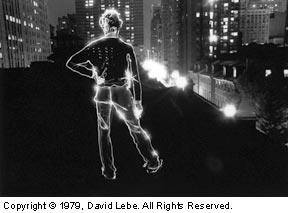
After a career change in 1988, I became a darkroom assistant to David Lebe as he was just beginning the 16 x 20″ prints from the Scribble series, his metaphoric light-drawings reflecting on life, death, and AIDS. (Later some were printed at 30 x 40″.) At the time, I was enrolled in a very tight photo program and found Lebe’s approach refreshing–much more intuitive than technical. He prefers to have an assistant rock trays, leaving him free to do the more creative work. We often discussed his decisions.
To walk into his house, at that time, was to walk into one of his still-life photographs. In the kitchen, adjacent to the darkroom, six cylinders of newly unpacked oatmeal were stacked in a pyramid, red and blue labels all oriented forward–a small construction probably done without thinking or concern for the fact that they would be placed in a cupboard only a while later. Throughout the wonderfully designed interior of his center-city townhouse were ever-changing arrangements of fresh or dried flowers, post-cards, shells, pebbles, dried fruit, found objects, or anything else that could be assembled, collected, or collaged. What ultimately appears in his photographs is often only an extension of the process by which he lives his life.
Lebe is one of those rare individuals who present themselves to the world without artifice or guile–as they are. The museum curator, the plumber, students, and friends all see the same person. Although originally a New Yorker, Lebe settled in slower-paced Philadelphia after attending the Philadelphia College of Art (1966-70), where he subsequently taught for eighteen years. He studied under Ray K. Metzker and Barbara Blondeau, placing him historically in the experimental lineage that starts at the Bauhaus, the seminal German art school, in 1918, and traces through Laszlo Moholy-Nagy, Harry Callahan, and Aaron Siskind at the Institute of Design in Chicago, where Metzker and Blondeau both studied. Somewhat of a technophobe, he only reluctantly calls himself a photographer. Rather, he is an artist who sets up a process using a repertoire of photographic techniques. Beginning with lens-less cameras a long time ago, his pinhole method influenced the way he would later work with other techniques. His attitude toward art and life may have much relevance for photographers and non-photographers alike.
Lebe is currently at work on new figurative images and has begun to reprint a comprehensive collection of photographs done between 1976 and 1992 for a possible book project and exhibition. David Lebe’s work is represented in the collections of the J. Paul Getty Museum, the Museum of Fine Arts, Houston, the Philadelphia Museum of Art, the Allentown (PA) Art Museum, The University of Maryland Baltimore County, and Haverford College, among others, and can be seen in numerous books including Flora Photographica, William A. Ewing, Simon & Schuster, 1991; The Homoerotic Photograph: Male Images from Durieu/Delacroix to Mapplethorpe, Allen Ellenzweig, Columbia University Press, 1992; Fully Expose & The Male Nude in Photography, Emmanuel Cooper, Unwin Hyman, Ltd., London, 1990; The Visionary Pinhole, Lauren Smith, Peregrine Smith Books,1985; and the catalogue, Truth Fantasy: David Lebe Photographs, published by the Albin 0. Kuhn Library,University of Maryland, 1987. He is represented by Paul Cava Fine Art, Bala Cynwyd, PA, the Catherine Edelman Gallery, Chicago, and The Vantage Gallery, Amsterdam.
The following interview took place in early September, 1993, in Lebe’s upstate New York studio in the house he and his life partner Jack Potter had just had built. Additions and clarifications were done by letter and telephone during the first few months of 1994.
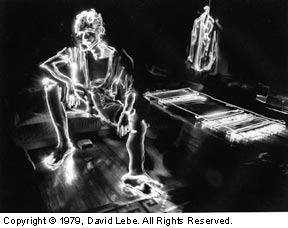
Richard Kagan: How did you get started with your earliest body of work, the pinhole photographs?
David Lebe: It was an assignment in school, part of a class where there were a number of short assignments. I made a camera and I did pinhole photography for the rest of the class. I never did any of the other projects.
RK: What was the subject matter? And what year was this?
DL: The first ones were of myself, and then of my friends and myself. I started the last year at PCA (Philadelphia College of Art, now University of the Arts), 1969-70, and kept using pinhole cameras for the next three or four years after I was out of school. That was pretty much it, except for an occasional picture. ‘75 was when I did the last one.
RK: What was it about pinhole photography that attracted you, that made you continue working the rest of that semester and afterward?
DL: Well, …at first it was just that I was excited by it. It was fascinating. It was fun. I wasn’t familiar with any other pinhole work that was being done, and I was discovering a lot. I think I got a real sense of what a camera was for the first time – an experiential sense of what a camera was. I was very comfortable using my 35mm camera, but it was an alien object. With the pinhole camera, it was something that I had built. It was magic. And yet it was clearer. I also liked being able to change the given, the basic structure, the format of the image that was made. The first thing that I did was to start doing multiple pinholes. And then the whole way of working was completely different. I had to relearn the whole process of photographing. With the 35mm camera, it was a matter of scanning and finding imagery. With the pinhole camera, I couldn’t do that. First of all, I didn’t have a viewfinder with my early nine-pinhole camera, and second, I couldn’t move the camera around very easily. I had to be near a darkroom, and the camera had to stay still. So, I think part of the excitement for me was learning the new process, inventing it in a way. Not that I was the first to do it, but nobody was telling me how it was done, so I was inventing it, and that was exciting. Instead of scanning, I was working intuitively within parameters I had set up. It became a basis for the way I continue to work even now. I also was able to walk around and get into the picture and that was, I thought, a lot of fun. Instead of being a “decisive moment,” the photograph became the decisive twenty minutes. My later photographs, the light drawings, were–in a way–a continuation of that. I learned that a photograph wasn’t necessarily an instant but could be a longer length of time–could be a whole event.
RK: You’ve worked with a number of very different processes, each in a very individual way–first, the pinholes, and hand-coloring, then photograms and light drawings.
DL: The diversity of form in the body of my work is something that I value very much. Not having acclaim early on, or even later on, made it easier (for me) to change the form of the work, and to work in ways that looked different at first glance, but to me often seemed very connected. There are many connecting visual threads as well as spiritual connections, and connections as to the intent or to the process.
RK: Would you describe your work in general, then and now, as process-related and perhaps more process-related than standard ways of working in photography?
DL: Technique is something I don’t pay a lot of attention to, but process is. I don’t worry so much about whether it’s a good camera or what kind of film I’m using. I think more about how I’m going to set up the picture. How am I going to interact with a model, if I’m using a model? How am I going to work to develop ideas? What’s going to be predetermined? How much am I going to work intuitively? How much is going to be structured before I start to work? How much is going to happen as I’m working? That’s what I think of as process–not so much about how long I’m going to develop the film. I use process to get at content. If the process is structured right, it can allow meaningful images to happen. I’ll leave it to someone else to talk about how that’s different from other ways of working.
RK: What are some of the other forms you use now?
DL: The two types of photographs that I started making after pinhole photography were photograms and what I call light drawings. Right now I’m doing a lot of still-lifes, set-ups in the studio, working in front of the camera to build a picture, very much like I worked with pinhole photography. I make light drawings by drawing with a flashlight in a darkened room while the film remains exposed for an extended period of time. In a way, it’s like the pinhole process when you open the camera and walk around in front of it and do something, although the light drawings are a much more animated process. With pinholes, you just sit there or move a couple of times. Again, it’s an extended kind of time frame for making the image. The photograms are a different way of building the image right on the paper. At the moment, I’m doing still-lifes, many of them with light drawing, some without.
RK: Can you describe a little of your technique for doing light drawings? What do you do? Do you open the lens and then walk into the photograph with a flashlight pointed at the camera?
DL: Right. The camera’s on a tripod, and I walk around in front of it with a flashlight and either draw freehand, or I outline, or I do whatever I’m going to do with the flashlight–move it different ways, at different speeds, point it in different directions. Sometimes, I’ll walk out of the picture and turn on another light source, a strobe, or a hot light of some sort to illuminate objects that are in front of the camera. I might do that with two light sources. Or whatever. Then, I’ll close the camera and repeat the photo five times, because you never know quite what’s going to come out, and if you do it five times, you’re more likely to have an image that you’re happy with.
RK: What led you to begin making light drawings?
DL: When the idea struck me, I was at home making self-portraits, wanting to be someplace else. That was 1976. I was shy and withdrawn and spent a lot of time alone in my small apartment where I did most of my work. Turning out the lights allowed me to eliminate the confinement and clutter, and also to imply the larger spaces or even vistas that I longed for, to place a figure in. The figure, of course, was me. By 1979, 1 started outlining other people outdoors. And then, later, I started drawing freehand.
RK: Let’s talk about the photograms. Most others that come to mind, including the well-known ones by Man Ray and Moholy-Nagy, are two-dimensional studies in composition. It’s interesting that many of yours are landscapes that not only create an illusion of space, but also imply movement and time. Why landscapes?
DL: At the time, I was very much rooted in the city. I had bought a townhouse in 1977, and made the photograms from plants I collected from my tiny roof garden and, later, from trips to the country. I was creating the gardens and landscapes I longed for. Along the way, other ideas got expressed.
RK: When I first saw them, the photograms appeared very serious. Now they seem whimsical, as well.
DL: Well, it was the opposite for me. When I was doing them, I thought of them as gardens and fantasy landscapes and was conscious of their whimsical and playful nature. I worked on them intensely but didn’t think much about the meaning until later. There were certainly sexual connotations suggested by the phallic forms. Also, I had this kind of secret notion that the things floating in space represented spirits, perhaps that had left the body. But it wasn’t an idea that I ever really talked about. I didn’t even know anybody who talked about such things. So, yes, there was a serious element, although I didn’t consciously put it there.
RK: Both the photograms and the light drawings seem like departures from the street and pinhole work you had been doing. What led to the change?
DL: Well, the first photograms and light drawings started after Barbara Blondeau, my friend and former teacher, died on Christmas Eve, 1974. Barbara had given me the original pinhole assignment, and she later gave me my first teaching job. It was my first experience with serious illness and death, and very painful emotionally. It had a strong effect on me.
A short time later, I was instrumental in putting together an exhibition and editing a catalogue of her work. Undoubtedly, my contact with that work was an important influence. Barbara had used a wonderful variety of playful techniques, and she often combined them with implications of death. Almost immediately and for the next year and a half, I began searching and experimenting with different forms–handcoloring, photograms, light drawings. Looking back on it now, much of the imagery in those experimental photographs reflected ideas of death, as well as sexuality.
RK: Coming back to the pinhole work, you said that not having a viewfinder forced you to give up control and stop pre-visualizing. Instead, you learned to set up situations to work intuitively and spontaneously within the limitations–and you started constructing images in front of the camera. I’m paraphrasing slightly. It seems interesting, your way of working and how it came out of the pinholes–that it isn’t about the moment. It’s about creating a situation in which you could be creative, spontaneous, and responsive to a whole lot of things that were going on. Perhaps, in some ways, more standard methods can stop or intimidate or prevent spontaneity, whereas the pinholes and light drawings may encourage it.
DL: It worked for me. In a way you have to find your form – what feels right, what works for you. You have those images within you, and you need to find a channel to get them out. It’s not necessarily the same channel for each person, or the same channel for each person at all times in his or her lives. Everything can change. Everything does change. And what will channel out images this week is not necessarily what’s going to channel them out next week.
RK: Where many photographers try to control the images, you seem to set up the process having only an idea of what’s going to happen.
DL: Not always a clear idea.
RK: But trusting your intuitive response in the situation?
DL: Yes. It’s something that I had to learn–to trust. It didn’t come right away, and I still don’t always trust that things will work. But I’ve learned over the years that probably something will happen. …You have to learn to trust that something is going to happen and allow it to happen. You have to learn to let go. More recently, AIDS has taught me to let go in other aspects of my life–a great lesson. My experience with photography may have helped me there. It’s a hard lesson to learn, to let go. It is for me, anyway. Maybe it’s not so hard for others.
RK: I suspect it’s very hard for photographers, in particular.
DL: Some photographers, yes, do tend to be very tight. I’ve learned to appreciate accidents, also. …Many of my photographs, you might say, are controlled accidents–accidents somewhat under control. Learning to recognize a good picture on the contact sheet is important, as important as learning how to make the picture.
RK: Your method of working sets up a discovery of visual images and also seems to set up a self-discovery. Can you talk about that connection and how self-discovery has been important for you?
DL: A lot of the work has been, in a way, about self-discovery. Often, I don’t know what my pictures are about until after I’ve made them–sometimes quite a bit after I’ve made them. …I had to learn to trust that the pictures are perhaps about something. And I don’t necessarily discover that right away. Sometimes I discover it while I am working on them, sometimes not till after I’m done making them.
RK: The Scribble series, for example?
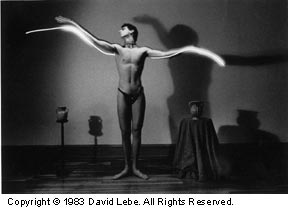
DL: Yes. With the Scribble series, I made all the pictures and then put the contacts and negatives away, thinking they were just frivolous nonsense, only to discover close to a year later that they were really significant pictures. I made them at a time when my former lover and close friend Barry, was dying of AIDS. I knew he was very close to death. I knew I needed to keep busy, and I felt a very strong urge to work–almost a compulsion. The last things I had done, some months before, were still-lifes with flowers, and I thought I would add some light drawings. Every day I would buy and then photograph the flowers and do the light drawing. It kept my mind busy and kept me working for a week or so. Then, one day, I forgot to buy flowers and dinner was over, and I wanted to work. I was quite annoyed. …It occurred to me that I didn’t need the flowers, I could just work with the light. Out of that came the Scribble series, which I think is one of my best series of work. In the course of my doing this work, my friend died. I stopped the series. I had printed a few pictures but thought they were frivolous and silly, and that I really had a responsibility to be making work that dealt with AIDS as a topic. The work should be about depression, about pain, about anger–about serious things, not playful patterns of light. Anyway, I put the Scribbles away for some time, and then, months later, when I was feeling more positive, I got interested in them again. I put some prints up to look at and think about. I listened to how people reacted to them. I realized, finally, that the pictures really were about AIDS. The light was spirit, and the vases represented bodies or funeral urns. The pictures were really a defiance of the fear and the pain, a kind of celebration of the spirits of so many who had died. They are an affirming memorial coming from my experience of knowing so many.
RK: Do you think you could have done the work had you started out wanting to express those concerns and feelings that you ultimately discovered after doing the work?
DL: No, the work would have been very self-conscious. Trite. Maybe somebody else could do it that way, but I can’t. If I have an intellectual thought or idea, a concept that I want to make pictures about, the picture becomes illustrative and often trite and obvious and loses its magic and its mystery, its soul and its spirit. It just becomes too plain and superficial. At least when I do it. Maybe other people can pull it off. There’s a lot of that work out there that seems self-conscious and obvious. People like it. It’s popular. It’s easier to understand and talk about, but I don’t find it very interesting.
By Richard Kagan
Printer Friendly Page (Entire Article)


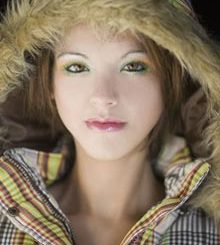
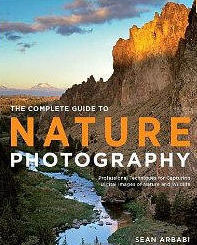
Leave a Reply